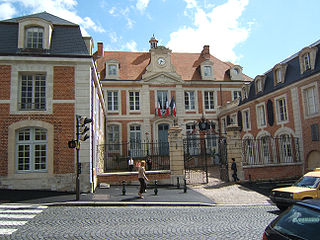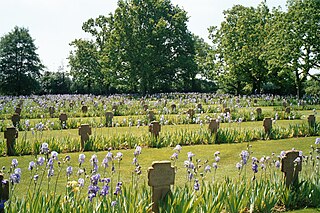
Calvados is a department in the Normandy region in northwestern France. It takes its name from a cluster of rocks off the Normandy coast. In 2019, it had a population of 694,905.

Boulogne-sur-Mer, often called just Boulogne, is a coastal city in Northern France. It is a sub-prefecture of the department of Pas-de-Calais. Boulogne lies on the Côte d'Opale, a touristic stretch of French coast on the English Channel between Calais and Normandy, and the most visited location in the region after the Lille conurbation. Boulogne is its department's second-largest city after Calais, and the 183rd-largest in France. It is also the country's largest fishing port, specialising in herring.

Le Portel is a commune in the Pas-de-Calais department in the Hauts-de-France region of France.

Aunay-sur-Odon is a former commune in the Calvados department in the Normandy region of north-western France. On 1 January 2017, it was merged into the new commune Les Monts d'Aunay.

Pont de Sèvres station is a station of the Paris Métro on Line 9, serving as its western terminus. It is located near the Pont de Sèvres, which is a bridge on the Seine connecting to Sèvres.

Lisieux is a commune in the Calvados department in the Normandy region in northwestern France. It is the capital of the Pays d'Auge area, which is characterised by valleys and hedged farmland.

Vire is a town and a former commune in the Calvados department in the Normandy region in northwestern France. On 1 January 2016, it was merged into the new commune of Vire Normandie.

The arrondissement of Boulogne-sur-Mer is an arrondissement of France in the Pas-de-Calais department in the Hauts-de-France region. It has 74 communes. Its population is 159,748 (2016), and its area is 633.7 km2 (244.7 sq mi).

The Military Administration in France was an interim occupation authority established by Nazi Germany during World War II to administer the occupied zone in areas of northern and western France. This so-called zone occupée was established in June 1940, and renamed zone nord in November 1942, when the previously unoccupied zone in the south known as zone libre was also occupied and renamed zone sud.

Operation Overlord was the codename for the Battle of Normandy, the Allied operation that launched the successful liberation of German-occupied Western Europe during World War II. The operation was launched on 6 June 1944 (D-Day) with the Normandy landings. A 1,200-plane airborne assault preceded an amphibious assault involving more than 5,000 vessels. Nearly 160,000 troops crossed the English Channel on 6 June, and more than two million Allied troops were in France by the end of August.
Henri Amouroux was a French historian and journalist.

Oye-Plage is a commune in the Pas-de-Calais department in the Hauts-de-France region of France.

The Military Administration in Belgium and Northern France was an interim occupation authority established during the Second World War by Nazi Germany that included present-day Belgium and the French departments of Nord and Pas-de-Calais. The administration was also responsible for governing the zone interdite, a narrow strip of territory running along the French northern and eastern borders. It remained in existence until July 1944. Plans to transfer Belgium from the military administration to a civilian administration were promoted by the SS, and Hitler had been ready to do so until Autumn 1942, when he put off the plans for what was intended to be temporary but ended up being permanent until the end of German occupation. The SS had suggested either Josef Terboven or Ernst Kaltenbrunner as the Reich Commissioner of the civilian administration.

Clearing the Channel Coast was a World War II task undertaken by the First Canadian Army in August 1944, following the Allied Operation Overlord and the victory, break-out and pursuit from Normandy.

The Bombing of Normandy during the Normandy invasion was meant to destroy the German communication lines in the Norman cities and towns. However, few German soldiers occupied these municipalities, who were mostly located elsewhere. On 9 July 1944, Field Marshal Bernard Montgomery ordered a massive air assault against Caen in the hopes of clearing the way for a ground attack the following morning. Four hundred and fifty heavy aircraft participated, dropping 2,500 tons of bombs. The pilots however negated most of the effect by releasing their bomb loads well back from the front line to avoid hitting their own troops. As a result, the city incurred heavy damage but German defenses went largely unscathed.

The Fortress of Mimoyecques is the modern name for a Second World War underground military complex built by the forces of Nazi Germany between 1943 and 1944. It was intended to house a battery of fixed V-3 cannons permanently aimed at London, 165 kilometres (103 mi) away. Originally codenamed Wiese ("Meadow") or Bauvorhaben 711, it is located in the commune of Landrethun-le-Nord in the Pas-de-Calais region of northern France, near the hamlet of Mimoyecques about 20 kilometres (12 mi) from Boulogne-sur-Mer. It was constructed by a mostly German workforce recruited from major engineering and mining concerns, augmented by prisoner-of-war slave labour.

The Fort of the Crèche is a coastal battery of the Séré de Rivières system, whose construction was completed in 1879. It is near Wimereux, in the Pas-de-Calais on the tip of Pointe de la Crèche. It is built on the remains of a Napoleonic defense system consisting of Fort Terlincthun and a sea fort, opposite the tip of the cape, of which only the foundations remain.

Saint-Désir-de-Lisieux is a Second World War German military war grave cemetery, located close to the village of Saint-Désir and 4 km (2.5 mi) west of Lisieux in the Calvados department, Normandy, France. It is located adjacent to the British Saint-Désir War Cemetery and is unique as the two burial grounds are linked by a pathway. It is the smallest German war cemetery in Normandy and contains the remains of 3,735 German military personnel. The cemetery was created by the British Graves Registration Commission in August 1944 with British and German casualties buried in adjacent fields.

The liberation of Rennes, along with its surrounding settlements, took place on 4 August 1944 by the joint action of the French Forces of the Interior (FFI) and the 8th Infantry Division of the United States Army led by General Georges S. Patton, ending four years of capture of the city by the Nazi Germans as part of the liberation of Brittany.

















